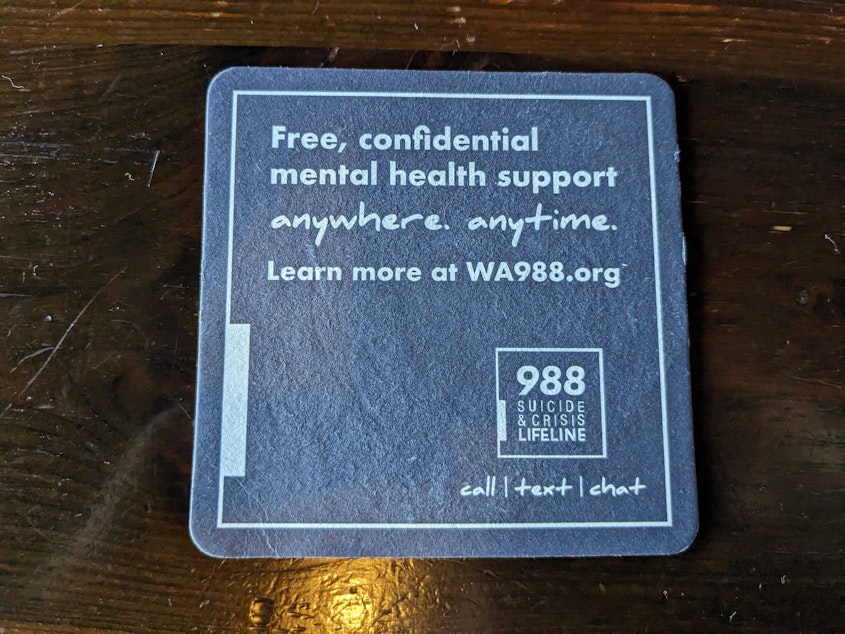In Seattle area, 988 mental health hotline supports tens of thousands in crisis

On Justin’s 18th wedding anniversary, his wife told him she didn’t love him — and she maybe never had.
“I felt so overwhelmed,” Justin said. “The world was crashing down around me, and I remembered there was this 988 number I could call.”
KUOW agreed not to use Justin’s last name to protect his privacy.
Justin said he wasn’t considering self-harm; he was having a panic attack. He was connected to someone almost immediately and talked to them for about 10 minutes.
“It was just really helpful to be able to talk to somebody right away who could hear me and reassure me,” he said.
Sponsored
RELATED: 988 hotline is going live. What is it for?
The national 988 mental health crisis line was rolled out in 2022. It replaces the old suicide hotline, a long 1-800 number thatwas hard to remember. And 988 isn’t just for people considering self-harm — it’s for people experiencing any mental health crisis or emotional distress. You can also call the number when you witness someone — a loved one or even a stranger — who appears to be in a behavioral health crisis.
As with 911, people get immediate help — but from a trained crisis counselor instead of law enforcement or paramedics. So far, close to 100,000 people have called or texted 988 from Puget Sound-based area codes.
When Justin called 988, “The person was very calm,” he said. They were helpful in large part because they were simply available, he added. “I was able to find somebody to talk to who could make me feel like I was tethered.”
They talked about next steps, and Justin said he planned to find a therapist.
Sponsored
988 in King County is now fielding about 40,000 calls a year, and about 15,000 text conversations. That’s growing rapidly from year to year, as more people learn about the hotline .
Anna Livingston is one of the people who might answer the phone if you call 988 from the 206 area code.
“I just say, ‘This is 988,’ and I give my name, and then I say, ‘I need to get some safety questions out right now,’” Livingston said. “Then I — it totally depends on the call. Some people are mad. Some people are hysterical, like crying.”
Livingston said she can relate to people in crisis because she’s had a lot of struggles in her own life. She used to be addicted to heroin, and she struggled to maintain custody of her daughters.
More than half the people who call 988 are considering self-harm, Livingston said.
Sponsored
RELATED: New 988 hotline is 'the front door' to help. But what's next for Washingtonians in need?
“A lot of it is, ‘OK, let’s take some deep breaths. Let’s go outside. What are your feet touching? What can you feel?’” Livingston said. “And then we usually try to clarify: What is the most important thing that we need to discuss?”
For most callers, the crisis is significantly de-escalated by the end of the call, and they don’t need anything more from 988.
“People just want to be heard,” Livingston said.
If necessary, 988 in King County has the ability to dispatch a mobile crisis team. And if the person answering the phone is worried about the caller’s safety, they’ll ask if they can connect them to 911.
Sponsored
988 is a huge improvement over 911 for people who don’t trust the police and don’t want them to get involved in their mental health crises, said Anna Nepomuceno, with the National Alliance on Mental Illness.
Still, she said, “There needs to be more education when it comes to 988, because a lot of people still don't know what's going to happen if they call.”
“A lot of communities of color do not feel comfortable calling 988 because they are afraid that law enforcement will show up,” she added.
Only in rare situations — less than 1% of all calls — does 988 call 911 on behalf of the caller, without their consent, said Michelle McDaniel, the CEO of Crisis Connections, which runs 988 in King County. But, she said, the public perception seems to be that 988 can trace calls, and send law enforcement, so she's working hard to change that.
Available data show that Black residents of King County are actually more likely to call 988 than white people, which suggests a higher need for crisis response in that community.
Sponsored
Nepomuceno said there’s still more work to do, especially outside of King County. She said King County has mobile response teams and a new behavioral health crisis center, resources that most communities don't have.
Sponsored
“To build trust, there needs to be more reassurance that when somebody calls, they get a therapeutic response and not a law enforcement response,” Nepomuceno said.
McDaniel said Crisis Connections is working on building that trust.
And soon, there will be more mobile crisis units funded by King County’s behavioral health levy, so they’ll have more options about how to respond to calls.
Editor's note 9/10/2024: This story was updated after publication to clarify Anna Nepomuceno’s comments.




